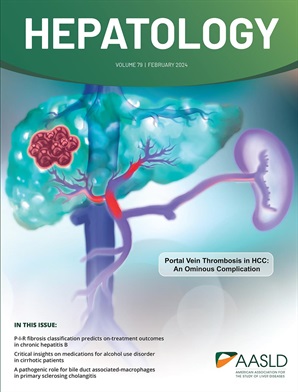RIPPLY1 suppresses cancer cell stemness via targeting TBX19 in CTNNB1-mutated hepatocellular carcinoma.
IF 15.8
1区 医学
Q1 GASTROENTEROLOGY & HEPATOLOGY
引用次数: 0
Abstract
BACKGROUND AIMS CTNNB1-mutated HCCs exhibit a relatively low stem-like and well-differentiated phenotype. However, the mechanism remains unclear. Ripply transcriptional repressor 1 (RIPPLY1), a transcriptional repressor required for somite segmentation, has hardly been studied in cancer. Here, we aim to unveil the role of RIPPLY1 in the regulation of cancer cell stemness in CTNNB1-mutated HCCs. APPROACH AND RESULTS RIPPLY1 was found to be transactivated by the Wnt/β-Catenin signal pathway. Human sample analysis confirmed that RIPPLY1 was significantly upregulated in CTNNB1-mutated HCC tissues and positively correlated with better prognosis of HCC patients. Hepatocyte-specific deletion of RIPPLY1 promoted tumorigenesis and progression in DEN/PB-induced CTNNB1-mutated HCC mouse model and hydrodynamic tail-vein injection (HDTVi)-induced CTNNB1-mutated HCC mouse model. RIPPLY1 knockout tumor cells displayed upregulated levels of stem cell makers and enhanced cancer stem cell properties. Co-IP and MS identified TBX19 as the target protein of RIPPLY1. RIPPLY1 suppressed the transcriptional activity of TBX19 via recruiting TLE1 and promoting proteasome-dependent degradation of TBX19. TBX19 deficiency abolished the effect of RIPPLY1 loss on cancer cell stemness in CTNNB1-mutated HCCs. CONCLUSION Loss of RIPPLY1 promotes cancer cell stemness via facilitating the TBX19 transcriptional activity in CTNNB1-mutated HCCs.RIPPLY1在ctnnb1突变的肝细胞癌中通过靶向TBX19抑制癌细胞的干细胞性。
背景:aimsctnnb1突变的hcc表现出相对较低的茎样和分化良好的表型。然而,其机制尚不清楚。RIPPLY1 (RIPPLY1)是一种体分割所需的转录抑制因子,在癌症中的研究很少。在这里,我们的目标是揭示RIPPLY1在ctnnb1突变的hcc中调控癌细胞干细胞性的作用。方法与结果发现ripply1被Wnt/β-Catenin信号通路反激活。人体样本分析证实,RIPPLY1在ctnnb1突变的HCC组织中显著上调,并与HCC患者预后较好呈正相关。在DEN/ pb诱导的ctnnb1突变肝癌小鼠模型和HDTVi诱导的ctnnb1突变肝癌小鼠模型中,肝细胞特异性缺失RIPPLY1促进了肿瘤的发生和进展。RIPPLY1基因敲除的肿瘤细胞表现出干细胞制造物水平上调和癌症干细胞特性增强。Co-IP和MS鉴定TBX19为RIPPLY1的靶蛋白。RIPPLY1通过募集TLE1和促进蛋白酶体依赖性TBX19降解来抑制TBX19的转录活性。TBX19缺失消除了RIPPLY1缺失对ctnnb1突变hcc中癌细胞干细胞性的影响。结论在ctnnb1突变的hcc中,RIPPLY1的缺失通过促进TBX19的转录活性来促进癌细胞的干细胞化。
本文章由计算机程序翻译,如有差异,请以英文原文为准。
求助全文
约1分钟内获得全文
求助全文
来源期刊

Hepatology
医学-胃肠肝病学
CiteScore
27.50
自引率
3.70%
发文量
609
审稿时长
1 months
期刊介绍:
HEPATOLOGY is recognized as the leading publication in the field of liver disease. It features original, peer-reviewed articles covering various aspects of liver structure, function, and disease. The journal's distinguished Editorial Board carefully selects the best articles each month, focusing on topics including immunology, chronic hepatitis, viral hepatitis, cirrhosis, genetic and metabolic liver diseases, liver cancer, and drug metabolism.
 求助内容:
求助内容: 应助结果提醒方式:
应助结果提醒方式:


